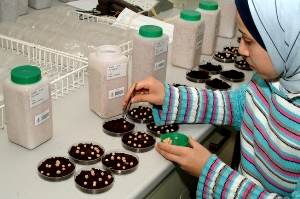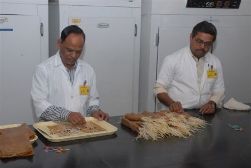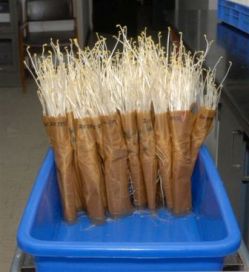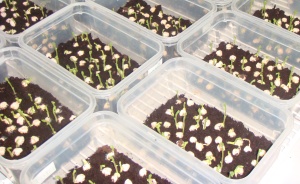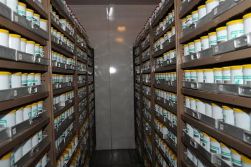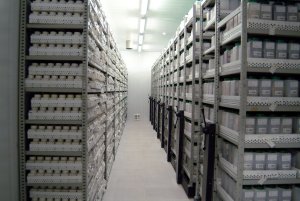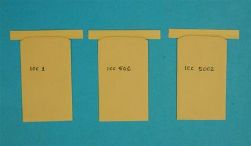CGKB News and events Chickpea
Viability of cultivated chickpea and wild relatives genetic resources
Contributors to this page: ICRISAT, Patancheru, India (Hari D Upadhyaya, Shivali Sharma, Cholenahalli L Laxmipathi Gowda, Dintyala Sastry, Sube Singh); NBPGR, New Delhi, India (Shyam Sharma); ICARDA, Aleppo, Syria (Ahmed Amri, Kenneth Street, Natalya Rukhkyan), SARC-RIPP, Piestany, Slovak Republic (Gabriela Antalikova); Institute of Plant Genetic Resources ‘K.Malkov’, Sadovo, Bulgaria (Siyka Stoyanova); Department of Primary Industries, Victoria, Australia (Bob Redden); IPK, Gatersleben, Germany (Andreas Börner).
|
Contents: |
|
|
| Using a sequential viability test on chickpea (photo: ICARDA) |
Laboratory methods
Describes the various recommended options, to test the viability and quality of chickpea seeds. The percentage of germination of the stored seeds of the accessions determines when regeneration of the accessions should take place and if the accession can be distributed to the users.
Type of test
When sufficient seed is available:
- Use a standard viability test (between paper, BP), following the ICRISAT Genebank Manual (Upadhyaya and Laxmipathi, 2009).
When the seed sample is small:
- Use a sequential viability test (following the FAO/IPGRI standards, 1994 and ISTA standards).
Number of seeds and replicates
- Use 50-100 seeds in 2-4 replications (following the ICRISAT Genebank Manual (Upadhyaya and Laxmipathi, 2009); FAO/IPGRI standards, 1994; Normative ISTA and AOSA; ‘Methodics examinations seed and plant, of State variety trials’. Bratislava. 1999. Slovak Republic).
Or
- 10 seeds in 2-4 replications (following the FAO/IPGRI standards, 1994).
Pre-treatment
Follow the recommendations of the ICRISAT Genebank Manual (Upadhyaya and Laxmipathi, 2009):
- Apply a dry seed treatment with fungicide at 3 g/kg seed.
- Scarify the seed coat for hard seeds, especially wild Cicer species.
|
|
| Germinated chickpea seeds using the between paper test (photos: ICRISAT) |
To avoid seed damage resulting from rapid moistening by liquid water in germination substrate, and to improve germination:
- Re-humidify (90% RH) seeds stored in dry and cool environments (-18oC).
- Pre-chill the re-humidified seeds (10oC for 48 hours) followed by germination according to ISTA standards.
Media
Following the recommendations of the ICRISAT Genebank Manual (Upadhyaya and Laxmipathi, 2009):
- Standard paper towel is best and cost effective.
- Alternatively, germination boxes with artificial soil (turf, vermiculate, etc.) using tap water may be used.
Temperature
According to the ICRISAT Genebank Manual (Upadhyaya and Laxmipathi, 2009) and the ISTA Standards:
- 20-25ºC.
Light
According to the ICRISAT Genebank Manual (Upadhyaya and Laxmipathi, 2009):
- Not required.
Duration of test
According to the ICRISAT Genebank Manual (Upadhyaya and Laxmipathi, 2009) and the ISTA Standards:
- 5-10 days after incubation.
Interpretation of results
According to the ICRISAT Genebank Manual (Upadhyaya and Laxmipathi, 2009) and the ISTA Standards (2003, 2005), Association of Official Seed Analysts (AOSA) Standards (2005):
- Scarify hard and ungerminated seeds and evaluate 14 days after incubation.
- If the mean viability percentage of the accession is below 85% (75% for wild species), repeat the test.
- Calculate the mean viability percentage from the results of the two tests and use this as the overall test result.
- If the results are far below the germination standard, the accession should be sent to regeneration.
Monitoring intervals
According to the ICRISAT Genebank Manual (Upadhyaya and Laxmipathi, 2009):
For the active collection (4ºC and 20-30% RH)
- Germination less than 85% - 5 years.
- Germination 85-95% - 8 years.
- Germination 95% or more - 10 years.
For the base collection (-20ºC)
- Germination less than 85% - 10 years.
- Germination 85-95% - 15 years.
- Germination 95% and more - 20 years.
Other option
According to Ellis' and Robert's predictive model with log parameters for initial viability, seed storage temperature and moisture content were used to monitor viability. This was more efficient than routine calendar interval monitoring of viability of collections such as every 5–10 years:
- As per predicted longevity: 20-30 years after initial regeneration and viability testing.
|
Using peatmoth for germination test of Chickpea
Germinated chickpea seeds (photos: ICARDA) |
Recording information during viability testing
The following information must be recorded for each testing step:
- Accession number (unique identification of the accession).
- Taxonomic identification (name).
- Date of storage (date when sample was stored in cold rooms).
- Date of testing (date when sampled was tested for viability).
- Substrate (type of paper used as substratum).
- Temperature [incubation temperature (ºC)].
- Incubation time [incubation period (days)].
- Replications / No. of seeds (number of replications and number of seeds tested).
- Date (date of testing).
- Pre-treatment.
- Days (days from the test date).
- Total germinated [number of seeds germinated in each category (normal, abnormal, non-germinated, hard seeds)].
- Abnormal (number of abnormal seedlings).
- Hard/dormant (number of hard/dormant seeds).
- Dead (number of dead seeds).
-
Germination % (counted on normal seedlings only).
- Seedlings should be judged as normal according to specific criteria - use ISTA Standards (2003, 2005), Association of Official Seed Analysts (AOSA) Standards, (2005).
Routine monitoring
Describes the recommended monitoring methods to assure minimum viability and quantity of seeds in storage.
- Routine inventory management of active collection and base collection using a Genebank Information Management System (GIMS).
- Aim viability of germplasm seed stock at 85% or more, based upon seed age and predicted viability from storage trial (to keep viable seed of all accessions available for distribution, and that seed stock is sufficient for both regeneration and distribution requirements).
- Monitor when seed quantity in active storage falls below 100 g.
- Monitoring – five years in the active collection, ten years in the base collection (recommended in the FAO/IPGRI standards, 1994).
- Use the computerized stock control system to monitor the quality and quantity of seed accessions in the cold store.
Monitoring frequency
Recommends the minimum quantity and minimum viability of seeds below which they need to be regenerated.
Critical quantity
To be detected by data on stocks in the Genebank Information Management System (GIMS) (according to FAO/IPGRI standards, 1994; ISTA Standards).
- For the active collection: critical quantity less than 100 g.
- For the base collection: When the number of seeds falls below the number required for at least three cycles of regeneration.
- For wild Cicer: 300 seeds.
Critical germination level
To be detected by data on stocks in the Genebank Information Management System (GIMS) (according to FAO/IPGRI standards, 1994; ISTA Standards).
- For the active collection: critical germination level less than 75%.
- For the base collection: when viability falls below 85% of the initial value.
- For wild Cicer: critical germination level: less than 75%.
Recording information during storage monitoring
The following information should be recorded for each step:
- Accession identifier/number (unique identifier of the accession).
- Season of crop harvest (mm/yyyy).
- Site of regeneration (place where the samples were regenerated).
- Container (type of container used for storage).
- No. of containers (total number of containers used for storing the sample).
- Date of storage [date on which the sample was stored in the genebank (dd/mm/yyyy)].
- Location in genebank (exact location where the sample is placed in the genebank).
- Seed quantity (g) (quantity of seeds currently available in storage).
- Germination (%) (percentage of seed germination resulting from the recent germination test conducted).
- Date of germination testing [date on which seeds were tested for germination (dd/mm/yyyy)].
- Remarks (any significant observation).
- Active or base storage.
- Age of seed [track age of seed from last regeneration date, or original if seed is from outside sources mostly with unknown storage conditions. This is an indirect guide to viability risk (aim applying predictive model].
- Passport information (follow the Multi-Crop Passport Descriptors, MCPD - Mandatory fields for passport information).
- Seed moisture content (% wet basis).
- Date when accession was sent for regeneration (date, person) [date accessions were sent for regeneration in the field (dd/mm/yyyy)].
- Date of receiving newly regenerated seeds of the accession (date, seed germination, others). According to accepted protocols for seed handling in genebanks.
- Number of regenerations (frequent regeneration can affect germplasm identity).
- Date of next test (one year: if germination % is close to critical value; five years: when it is above 85%).
References and further reading
AOSA (Association of Official Seed Analysts). 2005. In: Rules for Testing Seeds (Capashew Ed.), 4-0, 4-11. Las Cruces, NM. pp.113.
Bratislava. 1999. Methodics examinations seed and plant, of State variety trials. Slovak Republic.
GIMS (Genebank Information Management System) – a standalone facility of ICRISAT Genebank. International Crops Research Institute for the Semi-Arid Tropics, Patancheru, A.P. 502 324, India. In: Manual of Genebank Operations and Procedures - Technical Manual no. 6. International Crops Research Institute for the Semi-Arid Tropics, Patancheru 502 324, Andhra Pradesh, India: ISBN 92-9066-421-5.
FAO/IPGRI. 1994. Genebank standards. Food and Agriculture Organization of the United Nations, Rome and International Plant Genetic Resources Institute, Rome. Available in English, Spanish, French and Arabic.
FAO/IPGRI. 2001. Multi-Crop Passport Descriptors. FAO and IPGRI, Rome, Italy. Available in English, French and Spanish.
ISTA. 1993. International rules for seed testing. International Seed Testing Association. Bassersdorf, Switzerland. Seed Science and Technology 21 (Supplement):1-288.
ISTA. 2003. International rules for seed testing. International Seed Testing Association. Bassersdorf, Switzerland.
ISTA. 2005. International rules for seed testing. International Seed Testing Association. Bassersdorf, Switzerland.
Rao NK, Hanson J, Dulloo ME, Ghosh K, Nowel D, Larinde M. 2006. Manual of seed handling in genebanks. Handbooks for Genebanks No. 8. Bioversity International, Rome, Italy. Available in English (1.5 MB), Spanish (1.4 MB) and French (1.9 MB).
Upadhyaya HD, Laxmipathi Gowda CL. 2009. Managing and Enhancing the Use of Germplasm – Strategies and Methodologies. Technical Manual no. 10. Patancheru 502 324, Andhra Pradesh, India: International Crops Research Institute for the Semi-Arid Tropics. 236 pp.
Health diagnosis of cultivated chickpea and wild relatives
Contributors to this page: ICRISAT, Patancheru, India (Hari D Upadhyaya, Shivali Sharma, Cholenahalli L Laxmipathi Gowda, Dintyala Sastry, Sube Singh); NBPGR, New Delhi, India (Shyam Sharma); ICARDA, Aleppo, Syria (Ahmed Amri, Kenneth Street, Natalya Rukhkyan), SARC-RIPP, Piestany, Slovak Republic (Gabriela Antalikova); Institute of Plant Genetic Resources ‘K.Malkov’, Sadovo, Bulgaria (Siyka Stoyanova); Department of Primary Industries, Victoria, Australia (Bob Redden); IPK, Gatersleben, Germany (Andreas Börner).

Germplasm seed health testing (photo: ICRISAT) |
List of pests and diseases of quarantine importance
Click here for more detailed outputs from the page of the safe transfer of germplasm, on this site.
The list below mentions some of the pests/diseases that were considered important worldwide, but many of them may or may not have relevance in specific countries. It also does not consider pests/diseases of limited relevance (e.g. only important in very few countries).
Insects
- Kapra beetle (Trogoderma granarium) (Papua New Guinea).
- Bruchids (Callosobruchus chinensis L.).
Fungus
- Ascochyta rabiei (Chile and Mauritius).
- Pod and stem blight (Phomopsis longicola) (India - www.Plantquarantineindia.org).
Bacteria
- Pseudomonas syringae pv pisi (Iran and Kenya).
- Corynebactirium flaccumfaciens (Madagascar).
Virus Pea seed borne mosaic poty virus (Malawi and Israel).
- Alfa-alfa mosaic virus (Malawi and Israel).
Options for testing procedures
Recommended methods to detect the presence of each pest or disease:
- Kapra beetle (Trogoderma granarium) - Visual examination.
- Alternaria alternate - Freezing blotter method, PDA.
- Botrytis cinerea - PDA.
- Colletotrichum dematium - Paper toweling.
- Fusarium wilt (Fusarium oxysporum f. sp. ciceris) - Freezing blotter method, PDA.
- Phoma medicaginis - Freezing blotter method, PDA.
- Rhizoctonia bataticola – PDA.
- Ascochyta rabiei - Agar plate; Freezing blotter method.
- Pseudomonas syringae pv pisi and Corynebactirium flaccumfaciens - Agar Plate, Biochemical and PCR.
- Pea seed borne mosaic poty virus and alfa-alfa mosaic virus - ELISA and Electron Microscope, Growing them out.
- Orobanche spp.- Filter wash test.
- Cuscuta spp. - Filter wash test.
- Xanthomonas cassiae - Semi-selective medium.
- Bruchids (Callosobruchus chinensis L.) - Visual examination.
Testing intervals/seasons
- Testing before material goes into the genebank or to the field is important to reduce transfer of diseases or pests.
- Plants should be tested at 7-32 days based on the type of testing procedures (according to the Germplasm Exchange and Quarantine of ICRISAT Mandate Crops).
However, under natural field conditions, the following best practices are recommended:
Ascochyta rabiei
- Field inspection at all stages, followed by rouging off infected plants or/and seed health testing.
Alternaria alternate, Botrytis cinerea, Colletotrichum dematium
Fusarium wilt Fusarium oxysporum f. sp. ciceris
Phoma medicaginis
Rhizoctonia bataticola
- Field inspection all stages, rouging and seed health testing.
Orobanche spp., Cuscuta spp.
Xanthomonas cassiae
- Field inspection at flowering stage, rouging before seed dispersal and burn the plants.
Recording information during health diagnosis
The following information should be recorded for each health diagnosis step:
- Accession name (unique identification of the accession).
- Date of testing and examination [date of test and recording observations (dd/mm/yyyy)].
- Field number (to record the history of the field).
- Method of testing (method followed).
- No. of seeds tested (e.g. 50).
- Germination % (percentage of seeds germinated).
- Pathogens detected (record on pathogens identified).
- Percent of seed infected (percentage of seeds with infection to the number of seeds tested).
- Remarks (any other observations).
References and further reading
Chakrabarty SK, Anitha K, Girish AG, Sarath BB, Prasada RRDVJ, Varaprasad KS, Khetarpal RK, Thakur RP. 2005. Germplasm Exchange and Quarantine of ICRISAT Mandate Crops. Information Bulletin No. 69. Rajendranagar 500 030, Andhra Pradesh, India: National Bureau of Plant Genetic Resources; and Patancheru 502 324, Andhra Pradesh, India: International Crops Research Institute for the Semi-Arid Tropics. 80 pp. ISBN 92-9066-481-9.
Storage of cultivated chickpea and wild relatives genetic resources
Contributors to this page: ICRISAT, Patancheru, India (Hari D Upadhyaya, Shivali Sharma, Cholenahalli L Laxmipathi Gowda, Dintyala Sastry, Sube Singh); NBPGR, New Delhi, India (Shyam Sharma); ICARDA, Aleppo, Syria (Ahmed Amri, Kenneth Street, Natalya Rukhkyan), SARC-RIPP, Piestany, Slovak Republic (Gabriela Antalikova); Institute of Plant Genetic Resources ‘K.Malkov’, Sadovo, Bulgaria (Siyka Stoyanova); Department of Primary Industries, Victoria, Australia (Bob Redden); IPK, Gatersleben, Germany (Andreas Börner).
|
Contents: |
Base collection
|
|
| Long-term storage facility (photo: ICRISAT) |
A base collection is a long-term storage. The initial population is used as a bench mark for monitoring changes in genetic diversity over time and after several cycles of regeneration due to genetic drift. It should ensure that an accession’s seed viability remains at acceptable levels for at least 50 years, or at least one cycle of the regeneration of the accession.
When it should be used
- When aiming to store seeds for 50-100 years (Upadhyaya and Laxmipathi, 2009); FAO/IPGRI Standards, 1994).
-
Priority should be given to landraces, released varieties, wild relatives of crops and special genetic stocks.
- Landraces contain the greatest crop diversity with accessions adapted to a myriad of agro–ecological environments through long-term evolution in these localities.
- Breeding lines do not qualify as they are of short-term interest to breeders and continually displaced with each new breeding cycle.
- When needing to rejuvenate the medium-term collections, often after three multiplication cycles (so as to maintain genetic integrity of the original population).
Sample specifications
Minimum sample size for storage
A representative sample should be used to avoid genetic drift (Upadhyaya and Laxmipathi, 2009).
- For cultivated species: 1500-2000 seeds.
- For wild Cicer species: 300 seeds.
Minimum viability for storage
- Cultivated species: seeds with 90% or more viability.
- Wild Cicer species: seeds with 80% or more viability.
Moisture content
Important to avoid any deterioration pf the stored seed samples.
- 5-7% (FAO/IPGRI Standards, 1994).
Container specifications
Seed packaging method
Follow the procedures of the ICRISAT Genebank Manual (Upadhyaya and Laxmipathi, 2009).
- Prepare and label the aluminum foil packets with computer generated self-adhesive labels with the accession number, identity and season of harvest.
- Take out few samples at the time from the drying room to minimize re-absorption of moisture by the seed lot.
- Weigh the amount of seed prepared for storage and fill the container with seeds having at least 2.5 cm headspace for labelling.
- Place a non-adhesive label highlighting accession number, identity and season of harvest inside the packet.
- Seal the container using a standard vacuum sealer.
- Check for any deficiencies in packets and sealing.
- Print the date of sealing on the packet and move the samples to the long-term storage.
Specifications of packaging material
Follow the procedures of the ICRISAT Genebank Manual (Upadhyaya and Laxmipathi, 2009) and FAO/IPGRI Standards, 1994.
-
Use three layered standard aluminum foil packets consisting of the following layers:
- Polyester 17 g/m2 (an outer layer of 17 g Melinex and 4 g lacquer).
- Alufoil 33 g/m2 [a middle layer of 33 g (12 mm) aluminum foil and 4 g lacquer].
- Polyethylene 63 g/m2 (an inner layer of 63 g polyethylene).
- Use packets size of 190 x 160 mm for holding approximately 200 g of seed.
Storage specifications
Assigning location codes
Follow the procedures of the ICRISAT Genebank Manual (Upadhyaya and Laxmipathi, 2009).
- Use the exact location where the sample will be stored in the base collection (e.g. coded as 05-A-VI-06-132 indicating the room, rack, bay, shelf and tray numbers).
- Use computerized codes (for quick and easy retrieval of material).
- Use a barcode system (Genebank Information Management System, GIMS).
Storage conditions
- At -20ºC (FAO/IPGRI Standards, 1994).
Recording information during storage – Base collection
The following information should be recorded for each step:
- Accession identifier/number.
- Season of accession regeneration.
- Site of regeneration (location where germplasm was regenerated).
- Date of storage [long-term (LT) storage of sample (dd/mm/yyyy)].
- Location [location of the accession in the cold room (LT)].
- Seed quantity [weight of the seeds (g)].
- 100-seed weight (g) (100 randomly selected seeds).
- Type of container (for storing seeds - usually laminated aluminum foil for LT storage).
- Container number [number of seed containers for each accession (e.g. 1)].
- Seed moisture content (between 5-7% for LT storage).
- Germination % of the accession.
- Date of germination test (dd/mm/yyyy).
- Seed health status.
- Next recommended viability test date.
- Donor ID/Alternate ID/ Collector No. (collector’s name, donor name, any other alphanumeric character).
- Remarks (any other information).
For large genebanks with active, base and safe duplication strategies, the following alternative is recommended (ICARDA model):
- Weight of the sample.
- Number of seeds (estimated from weight using 1000 seeds).
- Number of packets.
- Year of production of seeds.
- Viability (%).
- Viability test date.
- Recommended next viability test date.
- Flag for regeneration (Y/N).
- Position of the sample in the storage.
Active collection
|
Active collection storage facility (photo: ICRISAT) |
|
Active collection at ICARDA (photo: ICARDA) |
An active collection consists of accessions that are available for distribution and are accessed frequently. The active collection is intended to preserve germplasm viability in a medium-term storage conditions for at least 20 years or for half of one regeneration cycle in the base collection.
When it should be used
- When aiming to store for 10-25 years (Upadhyaya and Laxmipathi, 2009 and FAO/IPGRI Standards, 1994).
- Used for immediate multiplication, distribution and use.
Sample specifications
Minimum sample size for storage
Follow the procedures of the ICRISAT Genebank Manual (Upadhyaya and Laxmipathi, 2009).
- Cultivated species: 400 g seeds.
- Wild Cicer species: 500 seeds.
Minimum viability for storage
Follow the procedures of the ICRISAT Genebank Manual (Upadhyaya and Laxmipathi, 2009).
- Cultivated species: seeds with 85% or more viability.
- Wild Cicer species: seeds with 80% or more viability.
Moisture content
To avoid any deterioration of the stored seed samples.
- 8-10% (Upadhyaya and Laxmipathi, 2009).
Container specifications
Seed packaging method
- Rust-proof aluminum cans with screw caps and rubber gaskets (Upadhyaya and Laxmipathi, 2009)).
Or
- Plastic containers (as used in ICARDA).
Specifications of packaging material
- Aluminum cans of 10 x 7.5 cm (Upadhyaya and Laxmipathi, 2009).
- Plastic containers 19.5 x 8.5 x 8.5 cm3 semi-transparent and withstanding low temperatures (as used in ICARDA).
Storage specifications
For easy access and location of the accessions.
Assigning location codes
- Use the exact location where the sample will be stored in the active collection (e.g. coded as 02-A-VI-06-15 indicating the room, rack, bay, shelf and tray numbers) (Upadhyaya and Laxmipathi, 2009).
- Use a barcode system (Genebank Information Management System, GIMS).
Storage conditions
- At +4ºC and 30% RH (Upadhyaya and Laxmipathi, 2009).
Recording information during storage – Active collection
The following information should be recorded for each step:
- Accession identifier/number.
- Season of accession regeneration).
- Site of regeneration (location where germplasm was regenerated).
- Date of storage [medium-term (MT) storage of sample (dd/mm/yyyy)].
- Location [location of the accession in the cold room (MT)].
- Seed quantity [weight of the seeds (g)].
- 100-seed weight (g) (100 randomly selected seeds).
- Type of container [container type for storing seeds (usually aluminum cans for MT storage).
- Container number [number of seed containers in each accession (e.g. 1)].
- Seed moisture content (between 8-10% for MT storage).
- Germination % of the accession).
- Date of germination test (dd/mm/yyyy).
- Seed health status.
- Next recommended viability test date.
- Donor ID/Alternate ID/ Collector No. (collector’s name, donor name, any other alphanumeric character).
- Number of times sampled for distribution (track distribution).
- Remarks (any other information).
For large genebanks with active, base and safe duplication strategies, the following alternative is recommended (ICARDA model):
- Weight of the sample.
- 1000-seed weight.
- Number of seeds (estimated from weight using 1000 seeds).
- Number of packets.
- Year of production of seeds.
- Viability (%).
- Viability test date.
- Next recommended viability test date.
- Flag for regeneration (Y/N).
- Position of the sample in the storage.
- Flag indicating distribution status (A, L, S).
For information on safety duplication, click here.
Storage management
Storage space arrangement
It is very important to provide easy access to the accessions.
If the genebank's main function is distibution of germplasm, then adopting a two-step storage system for maintaining active collections and base collections at controlled environments is recommended, otherwise a long-term storage condition should be adopted (Upadhyaya and Laxmipathi, 2009).
System for tracking material/inventory system
Samples must be quickly accessed.
- Develop a facility/database for tracking various operations including the inventory management for active, base and duplicate collections on Genebank Information Management System (GIMS):
-
- Passport details.
- Seed storage details.
- Sample location/position in cold rooms.
- Distribution of accessions (in the country and abroad).
- Storage should be arranged by crop and by accession number within the crop. Accession pouches should be labelled internally and externally with durable numbered and barcoded waterproof labels.
- Separate blocks of accession numbers with large margins should be assigned for each crop. This facilitates the correct retrieval of germplasm for distribution and for regeneration.
References and further reading
FAO/IPGRI. 1994. Genebank standards. Food and Agriculture Organization of the United Nations, Rome and International Plant Genetic Resources Institute, Rome. Available in English, Spanish, French and Arabic.
GIMS (Genebank Information Management System) – a standalone facility of ICRISAT Genebank. International Crops Research Institute for the Semi-Arid Tropics, Patancheru, A.P. 502 324, India. In: Manual of Genebank Operations and Procedures - Technical Manual no. 6. International Crops Research Institute for the Semi-Arid Tropics, Patancheru 502 324, Andhra Pradesh, India: ISBN 92-9066-421-5.
Stoyanova SD. 2001. Ex situ conservation in the Bulgarian genebank. I. Effect of storage. PGR-Newsletter 128:68-76.
Upadhyaya HD, Laxmipathi Gowda CL. 2009. Managing and Enhancing the Use of Germplasm – Strategies and Methodologies. Technical Manual no. 10. Patancheru 502 324, Andhra Pradesh, India: International Crops Research Institute for the Semi-Arid Tropics. 236 pp.
Distribution of cultivated chickpea and wild relatives genetic resources
Contributors to this page: ICRISAT, Patancheru, India (Hari D Upadhyaya, Shivali Sharma, Cholenahalli L Laxmipathi Gowda, Dintyala Sastry, Sube Singh); NBPGR, New Delhi, India (Shyam Sharma); ICARDA, Aleppo, Syria (Ahmed Amri, Kenneth Street, Natalya Rukhkyan), SARC-RIPP, Piestany, Slovak Republic (Gabriela Antalikova); Institute of Plant Genetic Resources ‘K.Malkov’, Sadovo, Bulgaria (Siyka Stoyanova); Department of Primary Industries, Victoria, Australia (Bob Redden); IPK, Gatersleben, Germany (Andreas Börner).
|
Contents: |
Policies and regulations for distribution
Common policies on distribution and access to plant material
- Standard Material Transfer Agreement (SMTA) for distribution of in-trust germplasm accessions [International Treaty on Plant Genetic Resources for Food and Agriculture (ITPGRFA)].
- Germplasm distribution free of charge for limited quantities.
- Unrestricted access to germplasm for research and development.
Policy exceptions
- Germplasm Acquisition Agreement (GAA) (ITPGRFA).
- Black-box storage.
- Multi-lateral system (MLS) for germplasm exchange with Conference of Parties (COP) to the Treaty.
- Collaborative Projects between Government organizations/institutes.
National laws and regulations
Based on countries' sovereign rights over germplasm and National Biodiversity Policies:
- Germplasm Acquisition Agreement (GAA).
- Import permit.
- Phytosanitary certificate (PSC).
- GMO-free certificate.
- Certificate of origin.
- Letter of donation (with no commercial value).
- Plant quarantine orderv(regulation of import into India), 2003.
- Biological Diversity Act (2002).
International laws and regulations
Based on the ITPGRFA, Convention on Biological Diversity (CBD), Germplasm Exchange and Quarantine of ICRISAT Mandate Crops.
- Germplasm Acquisition Agreement (GAA).
- Import permit.
- Phytosanitary certificate (PSC).
- Standard Material Transfer Agreement (SMTA).
- Others.
Phytosanitary regulations
- Phytosanitary certificate (PSC).
- Certificate of origin and GMO-free certificate (Plant Quarantine Order 2003, Government of India, www.plantquarantineindia.org/).
User related issues for distribution
Feedback to users
This is based upon the various centres' practices and experience (aiming to respond promptly with required accessions):
- With all documents in place and limited number of accessions: one week within country.
- Aim to meet requests for germplasm within two weeks within Australia.
- Longer to overseas depending on postage and need for AQIS phytosanitary inspection.
- Requests for 100-500 accessions can take up to two weeks longer to assemble.
- Some requests are not specific and may take longer to clarify requirements.
- Phytosanitary inspections may require an additional time, even up to three to four weeks.
Customer assurance
Based on GIMS, Germplasm catalogues, SINGER database; PGRFA policy for free and open access to germplasm and documentation.
- Improved and updated characterization and passport databases.
- Knowledge on the collection.
- Well classified and documented information on collections.
- The material is sent based upon the type of request (targeted/non-targeted).
Feedback from users
Send a Germplasm Utilization Feedback form with every supply, with the following issues:
- Comments on the appropriateness of the material supplied.
- Voluntary feedback of evaluation data.
- Performance of the accessions under different environmental conditions and the special traits observed.
Quantity of material recommended to be distributed
Unless special urgent circumstances are presented (Upadhyaya and Laxmipathi, 2009):
- Cultivated chickpea – 100 seeds.
- Wild Cicer – 10 seeds.
Check availability
- Check the existence of seeds using the inventory management system and physical verification (Upadhyaya and Laxmipathi, 2009).
- Check the availability in stock using the inventory management system and physical verification (GIMS).
- Check the passport data, especially the status of designation using an electronic version of the databases (GIMS).
Preparing samples for distribution
-
Registering the request (GIMS).
- Do an automatic registration using the distribution module.
- Requests should be registered with a number and filed electronically for future feedback.
-
Preparing a list of accessions available with an inventory management system and manual (GIMS).
- Checking requirements for material transfer agreements using manual and electronic databases (GIMS).
-
Generating labels.
- Generate labels for the selected accessions using the module Numeric/bar code ID fixed with adhesive and stapled on all seed packets for each accession (GIMS).
-
Labelling the accession containers (Upadhyaya and Laxmipathi, 2009).
- Manual pasting on metal folding paper envelops.
- Label should be affixed to each seed packet and packets should be enclosed in a sealed plastic bag and placed in box / padded envelope for shipment.
- Check the inventory file and note the location of the container (Upadhyaya and Laxmipathi, 2009).
-
Remove containers from the genebank and perform the acclimatization procedures required (Upadhyaya and Laxmipathi, 2009).
- For smaller numbers of samples, containers should not be removed from the genebank. Samples should be directly drawn and kept under ambient conditions for supply.
- For large numbers of samples, take the containers from the genebank and move them out to a dehumidified room the previous evening to allow them to warm up to room temperature before opening.
-
Assuring accuracy in identification (GIMS).
- Cross-check identification with passport and characterization databases.
- Visual and barcode verification with label on storage pouch for each accession.
-
Extracting samples from the original containers.
- In a two-way system of active and base collections, the source for distribution should only be the active collection. The base collection and the reference samples should not be used for seed supply (Upadhyaya and Laxmipathi, 2009).
Preparing the information list to accompany the plant material
According to the Genebank Manual of ICRISAT (Upadhyaya and Laxmipathi, 2009).
- Passport data (Germplasm Assembly Module of GIMS).
- Accession identification and alternate identity (Germplasm Assembly Module of GIMS).
- Source country (Germplasm Assembly Module of GIMS).
- Location and biological status (Germplasm Assembly Module of GIMS).
- Limited characterization data used to verify accessions (Germplasm Characterization Module of GIMS).
- Standard Material Transfer Agreement (SMTA).
- Cover letter (detailed cover letter on the consignment and related documents with necessary suggestions on using the material).
Dispatching the plant material
|
|
| Envelopes containing chickpea seeds ready for distribution (photo: ICRISAT) |
According to the Genebank Manual of ICRISAT (Upadhyaya and Laxmipathi, 2009)
- Pack the seed envelopes, covering letter, phytosanitary certificate, import permit, GMO free certificate and seed list in a jiffy bag or suitable size cardboard box.
- Label it with the complete address of the consignee.
- Use filling material to avoid damage to seeds during transit.
- Include a reply form.
- Attach acknowledgment letter and SMTA form for reply with every consignment.
- If germplasm is a wild species, additional information for germinating seeds is enclosed.
- Send the plant materials with a standard post, but may use courier, if urgent.
- Record shipping details, the request number, date of sending the material and destination for retracing, if material is lost in transit.
-
Update the inventory of genebank.
- Necessary for future distribution as well as for regeneration purposes.
- Dynamic updating of seed stock weight in collection is important, while packaging seed for request.
Recording information during distribution
The following information must be recorded for each accession:
- Status [inside supply/external supply (GIMS)].
- Reference number [an auto generated reference number e.g. Ext- 20/2008 (GIMS)].
- Name of crop [e.g. chickpea (GIMS)].
- Consignee’s name and designation, including the first name, last name (GIMS).
- Use Code [type of user e.g. University (GIMS)].
- Designation of the consignee (GIMS).
- Name of organization (GIMS).
- Type of cooperator [code (GIMS)].
- Name and address of organization [detailed address including the location, province, airport, pin code, fax/email (GIMS)].
- User information (type of organization requesting materials) – user code (GIMS).
- Name of country and region (GIMS).
- Type of material [e.g core collection (GIMS)].
- Date of receiving the germplasm request [e.g. dd/mm/yyyy (GIMS)].
-
Request type (GIMS):
- Mode of request (e.g. email).
- Specificity of request (e.g. targeted/non-targeted).
- SMTA status [e.g. received/form sent (GIMS)].
- Date of supplying the samples [e.g. dd/mm/yyyy (GIMS).
- Number and quantity of samples provided [number of samples and quantity of seeds per sample (GIMS)].
- Phytosanitary certificate [a quarantine requirement (GIMS)].
- Export permit number (GIMS).
- Mode of dispatch [e.g. Airfreight/Courier (GIMS)].
- Receipt of acknowledgement (GIMS).
- Purpose of using germplasm [e.g. adaptation (GIMS)].
- Remarks [special requests, type of material (GIMS)].
- Others [passport data of requested germplasm sent electronically (GIMS)].
- Any other information.
System for tracking material/inventory system for distribution
- Inventory module for active and base collections should be updated with every sample transaction (GIMS).
- Physical verification at regular intervals for small collections (GIMS).
References and further reading
Chakrabarty SK, Anitha K, Girish AG, Sarath BB, Prasada RRDVJ, Varaprasad KS, Khetarpal RK, Thakur RP. 2005. Germplasm Exchange and Quarantine of ICRISAT Mandate Crops. Information Bulletin No. 69. Rajendranagar 500 030, Andhra Pradesh, India: National Bureau of Plant Genetic Resources; and Patancheru 502 324, Andhra Pradesh, India: International Crops Research Institute for the Semi-Arid Tropics. 80 pp. ISBN 92-9066-481-9.
Chickpea. [online]. Availalable from: http://www.icrisat.org/crop-chickpea.htm. Date accessed: 30 January 2010.
FAO/IPGRI. 1994. Genebank standards. Food and Agriculture Organization of the United Nations, Rome and International Plant Genetic Resources Institute, Rome. Available in English, Spanish, French and Arabic.
GIMS (Genebank Information Management System) – a standalone facility of ICRISAT Genebank. International Crops Research Institute for the Semi-Arid Tropics, Patancheru, A.P. 502 324, India. In: Manual of Genebank Operations and Procedures - Technical Manual no. 6. International Crops Research Institute for the Semi-Arid Tropics, Patancheru 502 324, Andhra Pradesh, India: ISBN 92-9066-421-5.
ICRISAT Chickpea collection. SINGER [online] Available from: http://www.singer.cgiar.org/index.jsp?page=showkeycount&search=coc=co38. Date accessed: 30 January 2010.
Upadhyaya HD, Laxmipathi Gowda CL. 2009. Managing and Enhancing the Use of Germplasm – Strategies and Methodologies. Technical Manual no. 10. Patancheru 502 324, Andhra Pradesh, India: International Crops Research Institute for the Semi-Arid Tropics. 236 pp.
More Articles...
Subcategories
-
Regeneration
- Article Count:
- 3
-
main
- Article Count:
- 1
-
Safety duplication
- Article Count:
- 1
-
Conservation
- Article Count:
- 7
-
Characterization
- Article Count:
- 1





